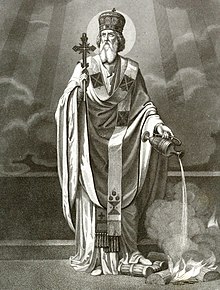| Abibos of Nekresi | |
|---|---|
 Abibos quenching holy fire in a Zoroastrian temple. Mikhail Sabinin, 1882. Abibos quenching holy fire in a Zoroastrian temple. Mikhail Sabinin, 1882. | |
| Bishop, Preacher, Martyr | |
| Died | Mtskheta, Georgia |
| Venerated in | Orthodox Church |
| Feast | December 12 |
Abibos of Nekressi (Georgian: აბიბოს ნეკრესელი, romanized: abibos nek'reseli) (fl. 6th century) was one of the thirteen Assyrian apostles of Georgia and the bishop of Nekresi who arrived in Georgia under the leadership of St. Ioane of Zedazeni (John of Zedazeni). He began his activity as bishop in a village which was located in the hills in the eastern region of Kakheti. According to the chronicle Life of Kartli, he spread Christianity not only among Georgians but also among the mountain tribes such as the Dagestani/Didoians, the ancient predecessors of modern Dagestan. At that time there was a period of Persian rule in eastern Georgia. The main religion of Persians was Zoroastrianism. St. Abibos is said to have doused a sacred Zoroastrian flame with water. He was captured by the Zoroastrian priests, was tied up and beaten before being brought to the marzban. Simeon the Stylite of the Wonderful Mountain sent him a letter, an eulogia (probably a piece of prosphoron) and a staff to strengthen his soul. He was stoned to death by Zoroastrian Persians at Rekhi and his body was dragged from the city and cast to the beasts.
In spite of the stringent prohibition to take his body the priests and monks of Rekhi stole it. They buried it with great honor at Samtavisi Monastery (located midway between Mtskheta and Gori). During the rule of Prince Stepanoz of Kartli, the relics of St. Abibos were relocated from Samtavisi to Samtavro Monastery in Mtskheta. They were buried under the holy altar at Samtavro Church.
His feast day had been kept on November 12 through 1700, but later changed to December 12 on the Gregorian calendar and November 29 on the Julian calendar correspondingly.
References
- "Holy Martyr Abibos of Nekresi (6th Century)", Pravaslavie.ru
- ^ Loosley Leeming, Emma (2018). "Architecture and Asceticism: Cultural Interaction between Syria and Georgia in Late Antiquity". Texts and Studies in Eastern Christianity, Vol. 13. Brill. 2018, p. 44ISBN 978-90-04-37531-4
- About Sights – Nekresi Monastery Retrieved on 21 Feb 2018
Sources
- Holweck, F. G. A Biographical Dictionary of the Saints. St. Louis, MO: B. Herder Book Co. 1924.
- Rapp Jr, Stephen H. (2017). The Sasanian World through Georgian Eyes: Caucasia and the Iranian Commonwealth in Late Antique Georgian Literature. Routledge. p. 145.